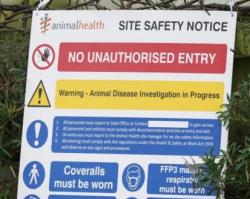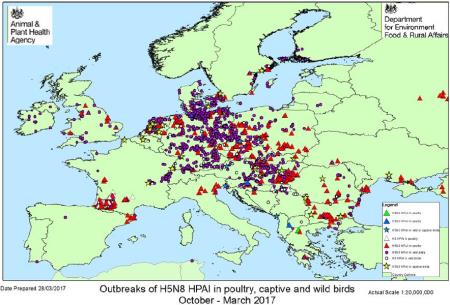Spread of HPAI in the U.K.
|
12/23/2020 |
|
  The extent to which migratory birds can disseminate avian influenza virus is indicated by an outbreak in a backyard flock on the island of Sanday in the Orkney Isles of Scotland. Thirty-nine of fifty-two free range chickens died of H5N8 avian influenza in a case documented on ProMed Mail on December 18th. The extent to which migratory birds can disseminate avian influenza virus is indicated by an outbreak in a backyard flock on the island of Sanday in the Orkney Isles of Scotland. Thirty-nine of fifty-two free range chickens died of H5N8 avian influenza in a case documented on ProMed Mail on December 18th.
On December 14th, the Chief Veterinary Officer of Scotland, Dr. Sheila Voas advised that all commercial poultry should be confined to housing. Avian influenza has not been recorded in Scotland for four years, but recently England has encountered H5N8 in swans, near the coast of Hampshire, on the Isle of Wight and in the counties of Warwickshire and Worcestershire. Commercial outbreaks have occurred in East Anglia and North Worcestershire.
According to the National Farmers Union of Scotland, "it is now a legal requirement for all bird keepers whether they have one hen in the back garden or a large poultry business, to keep their birds indoors and to follow strict biosecurity measures to limit the spread of avian influenza and keep out the disease". Animal Health Policy Manager for Scotland, Dr. Penny Middleton stated, "it is crucial that everyone remain vigilant to report any signs of disease both in domestic birds and wild birds at the earliest opportunity.
|
|

What may be facing the EU in 2020/2021
|
A joint statement from Britain's three Chief Veterinary Officers included "whether you keep just a few birds or thousands, from December 14th, 2020 onwards you will be legally required to keep your birds indoors. We have not taken this decision lightly, but it is the best way to protect your birds from this highly infectious disease". Since late November H5N8 HPAI has been reported from poultry, captive non-poultry birds and free-living species in France, Netherlands, Ireland, Belgium, Germany, Sweden, Slovenia, Croatia and Poland in addition to reports from Israel. Between August 15th and December 7th, 561 HPAI detections were reported in the fifteen EU/EEA nations of which 510 were in wild birds including geese, swans, and raptors including buzzards and falcons. Of the 43 outbreaks in commercial poultry, contact with wild birds was regarded as the primary means of introduction of infection. In addition to H5N8 the predominant strain, 17 isolates of H5N5 and six of H5N1 have been identified suggesting multiple virus introductions into Europe.
|
| Although authorities are emphasizing the fact that H5N8 is not transmissible to consumers, zoonotic H5N1 and H9N2 cases were reported in two individuals.
The implications for the U.S. are that surveillance of free-living birds is necessary as an early warning for the emergence of avian influenza in commercial flocks. In 2014, the first cases of HPAI were diagnosed in California during late December and the major epornitic commenced in March 2015 in the northern regions of the Mississippi valley. We should all look to our biosecurity. |

|
|
|